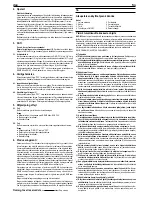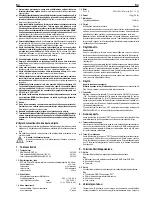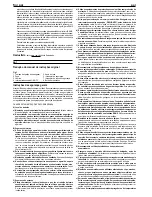
Translation of the original operating instructions
General Safety Rules
WARNING! To reduce the risk of injury, user must read and understand instruc-
tion manual.
WARNING!
Read all instructions. Failure to follow all instructions listed below may
result in electric shock, fire and/or serious injury. The term „power tool“ in all of the
warnings listed below refers to your mains operated (corded) power tool or battery
operated (cordless) power tool, also machines and electric units. Only use the power
tool for the purpose for which it was intended, with the due attention to the general
safety and accident prevention regulations.
SAVE THESE INSTRUCTIONS.
A) Work area
a) Keep work area clean and well lit.
Cluttered and dark areas invite accidents.
b) Do not operate power tools in explosive atmospheres, such as in the pres-
ence of flammable liquids, gases or dust.
Power tools create sparks which
may ignite the dust or fumes.
c) Keep children and bystanders away while operating a power tool.
Distrac-
tions can cause you to lose control.
B) Electrical safety
a) Power tool plugs must match the outlet. Never modify the plug in any way.
Do not use any adapter plugs with earthed (grounded) power tools.
Unmodi-
fied plugs and matching outlets will reduce risk of electric shock. If the power tool
comes with an earthed wire, the plug may only be connected to an earthed
receptacle. At work sites, in damp surroundings, in the open or in the case of
comparable types of use, only operate the power tool off the mains using a 30
mA fault current protected switch (FI breaker).
b) Avoid body contact with earthed or grounded surfaces such as pipes,
radiators, ranges and refrigerators.
There is an increased risk of electric shock
if your body is earthed or grounded.
c) Do not expose power tools to rain or wet conditions.
Water entering a power
tool will increase the risk of electric shock.
d) Do not abuse the cord. Never use the cord for carrying, pulling or unplug-
ging the power tool. Keep cord away from heat, oil, sharp edges or moving
parts.
Damaged or entangled cords increase the risk of electric shock.
e) When operating a power tool outdoors, use an extension cord suitable for
outdoor use.
Use of a cord suitable for outdoor use reduces the risk of electric
shock.
C) Personal safety
a) Stay alert, watch what you are doing and use common sense when operating
a power tool. Do not use a power tool while you are tired or under the influ-
ence of drugs, alcohol or medication.
A moment of inattention while operating
power tools may result in serious personal injury.
b) Use safety equipment. Always wear eye protection.
Safety equipment such
as dust mask, non skid safety shoes, hard hat, or hearing protection used for
appropriate conditions will reduce personal injuries.
c) Avoid accidental starting. Ensure the switch is in the off position before
plugging in.
Carrying power tools with your finger on the switch or plugging in
power tools that have the switch on invites accidents.
d) Remove any adjusting key or wrench before turning the power tool on.
A
wrench or a key left attached to a rotating part of the power tool may result in
personal injury.
e) Do not overreach. Keep proper footing and balance at all times.
This enables
better control of the power tool in unexpected situations.
f) Dress properly. Do not wear loose clothing or jewellery. Keep your hair,
clothing and gloves away from moving parts.
Loose clothes, jewellery or long
hair can be caught in moving parts.
g) If devices are provided for the connection of dust extraction and collection
facilities, ensure these are connected and properly used.
Use of these devices
can reduce dust related hazards.
h) Only allow trained personnel to use the power tool.
Apprentices may only
operate the power tool when they are over 16, when this is necessary for their
training and when they are supervised by a trained operative.
D) Power tool use and care
a) Do not force the power tool. Use the correct power tool for your application.
The correct power tool will do the job better and safer at the rate for which it was
designed.
b) Do not use the power tool if the switch does not turn it on and off.
Any power
tool that cannot be controlled with the switch is dangerous and must be repaired.
c) Disconnect the plug from the power source before making any adjustments,
changing accessories, or storing power tools.
Such preventive safety meas-
ures reduce the risk of starting the power tool accidentally.
d) Store idle power tools out of the reach of children and do not allow persons
unfamiliar with the power tool or these instructions to operate the power
tool.
Power tools are dangerous in the hands of untrained users.
e) Maintain power tools. Check for misalignment or binding of moving parts,
breakage of parts and any other condition that may affect the power tools
operation. If damaged, have the power tool repaired by a qualified expert
or by an authorised REMS after-sales service facility before use.
Many
accidents are caused by poorly maintained power tools.
f) Keep cutting tools sharp and clean.
Properly maintained cutting tools with
sharp cutting edges are less likely to bind and are easier to control.
g) Secure the workpiece.
Use clamps or a vice to hold the workpiece. This is safer
than holding it with your hand, and also it frees both hands to operate the equip-
ment.
h) Use the power tool, accessories and tool bits etc., in accordance with these
instructions and in the manner intended for the particular type of power
tool, taking into account the working conditions and the work to be performed.
Use of the power tool for operations different from those intended could result in
a hazardous situation. All unauthorised modifications to the power tool are
prohibited for safety reasons.
E) Battery tool use and care
a) Ensure the switch is in the off position before inserting battery pack.
Inserting
the battery pack into power tools that have the switch on invites accidents.
b) Recharge only with the charger specified by the manufacturer.
A charger
that is suitable for one type of battery may create a risk of fire when used with
another battery pack.
c) Use battery tools only with specifically designated battery packs.
Use of
any other battery packs may create a risk of injury and fire.
d) When battery pack is not in use, keep it away from other metal objects like
paper clips, coins, keys, nails, screws, or other small metal objects that
can make a connection from one terminal to another.
Shorting the battery
terminals may cause bums or a fire.
e) Under abusive conditions, liquid may be ejected from the battery, avoid
contact. If contact accidentally occurs, flush with water. If liquid contacts
eyes, additionally seek medical help. Liquid ejected from the battery may
cause irritation or bums.
f) Do not use the battery/charger at battery/charger temperatures or ambient
temperatures of ≤ 5°C/40°F or ≥ 40°C/105°F.
g) Do not dispose defective batteries in the normal domestic waste. Take them
to an authorised REMS after-sales service facility or to a reputed waste
disposal company.
F) Service
a) Have your power tool serviced by a qualified repair person using only
identical replacement parts.
This will ensure that the safety of the power tool
is maintained.
b) Comply with maintenance instructions and instructions on tool replace-
ments.
c) Check mains lead of power tool regularly and have it replaced by a qualified
expert or an authorised REMS after-sales service facility in case of damage.
Check extension cable regularly and replace it when damaged.
Specific Safety Instructions
● Do not overload the electric pipe shears. Only cut pipes which are listed under
‘1.2. Working range’. Not for use with metal pipes. Do not use damaged blades.
● Avoid contact with water, the cordless pipe shears are not water-protected.
● Warning, risk of injury!
Never grip in the area of the blade (3)! There is a danger of losing your
finger!
1. Technical data
1.1. Article numbers
REMS Akku-ROS P 40
291300
Blade for the REMS Akku-ROS P 40
291301
Charger for the REMS Akku-ROS P 40
291302
1.2. Working range, performance
Plastic pipes made from PVC, PP, PE, multi-layer
Ø ≤ 40 mm
Wall thickness
s ≤ 6.7 mm
Cutting performance
4 – 5 sec/cut
Continuous performance
200 cuts
Continuous operation
35 min
1.3. Electrical data
Cordless pipe shears with integral NiMH battery
9.6 V =; 1.0 Ah; 6 A
Charger for NiMH battery
Input
100 – 240 V ~
Output
12 V =; 500 mA; 6 W
1.4. Battery capacity
Number of cuts with 1 battery charge
ca. 250
Charging time of battery
2 hours
1.5. Dimensions
L × W × H:
225 × 180 × 103 mm (8,8” × 7.1” × 4”)
1.6. Weight
1.2 kg (2.5 lb)
1.7. Noise information
Emission at workplace
73 dB(A)
1.8. Vibrations
Weighted effective value of acceleration
2.5 m/s²
The indicated weighted effective value of acceleration has been measured
against standard test procedures and can be used by way of comparison with
eng eng
Fig. 1
1 Socket for connecting the charger
2 Hand grip
3 Blade
4 Slide switch ON/OFF
5 Pipe support
6 Safety switch
7 Safety tip switch (trigger)
8 Return button






































